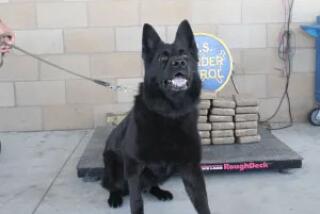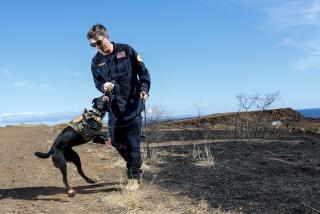Employer Tool : Dogs Nosing Out Drugs in Workplace
- Share via
EL CAJON, Calif. — The latest tool in the fight against employee drug abuse doesn’t involve bottles or test tubes. It boasts an accuracy rate of 97.5%, the results are instantaneous, and best of all, it’s man’s best friend.
To employees who either can’t or won’t leave their drugs at home, dogs are becoming a dreaded management weapon, trained to detect minute amounts of narcotics through their keen sense of smell.
To dog trainers Larry Katz and Chuck Staff, it’s a business that continues to grow.
Katz and Staff, both 36, started Biosensors two years ago. The firm trains dogs in the art of detecting “personal quantity” amounts of drugs. Dogs used by the U.S. Customs Service and other law enforcement agencies are trained to sniff out much larger quantities.
Mutts trained at Biosensors emerge as wonder dogs after about four months, capable of sniffing out traces of cocaine, marijuana, methamphetamine and other drugs that are finding their way into the workplace.
Katz and Staff said they had worked with dogs in law enforcement before and saw the demand for drug enforcement on the job.
That sent them dog shopping.
Friendly Dogs Used
“Normally, on our first visit, people are uptight and thinking all sorts of horrible things are going to happen, so we made a point of finding some friendly dogs,” said Katz. “We wanted the kinds of dogs you could take into an office without terrifying people.”
Skippy is one such dog. The mutt with the perpetual grin is Katz’s personal favorite. Time was running out for Skippy at the San Diego County Humane Society when Katz spotted him. When Skippy tried to break through the cage at the sight of a bouncing ball, Katz knew Skippy had the spirit and curiosity for what he had in mind.
During training, Staff and Katz teach the dogs to associate the odors of certain drug particles with a reward, which in Skippy’s case is the bouncing ball. When Skippy goes on a search, the bouncing ball goes with him and is tossed when the dog indicates he’s found drugs.
Biosensors’ clients range from posh hotels to defense manufacturers. A dozen regular clients pay from $100 to $1,800 a month, depending on their size, for regular searches. There are eight dogs on the force, but that number is expected to rise as the client list grows.
1st Step: Diffuse Anger
“Normally when we get called by a company, something bad has just happened,” Katz said. “There’s been an accident because someone was high on drugs, and the employer calls us and says, ‘We want to get the drugs outta’ here, we want to bust everybody, we want to put everybody in jail.’
“The first thing we try to do is diffuse their anger. We ask them if they want to be cops or get drugs off the work force. Once we calm them down, we can start talking rationally,” Katz said.
The goal of Biosensors is to alert employers to office drug problems. Neither the trainers nor the dogs touch employees or their personal belongings. If a dog detects drugs in a desk or locker, it’s up to the employer to confront the worker. Staff and Katz require employers to give two written notices before a search and post signs in the workplace.
Carl Hinrichsen, manager of employee relations at the National Steel & Shipbuilding Co. in San Diego, said dogs from Biosensors have searched the yard several times.
Dogs Are Passive
He said because the dogs are passive, workers have not felt threatened by their presence.
“Initially, the workers were very concerned about it,” Hinrichsen said. “But once they saw a demonstration of the dogs, there didn’t seem to be any great displeasure with them. We believe the dogs are a deterrent.”
After the warnings, Katz and Staff said they figure employees are either very stupid or very addicted to bring drugs to work.
“Nobody wants to lose their job over a (marijuana) joint,” Staff said. “Most of the recreational users just plain stop doing it when they know we’re going to be going in there. But the serious drug user is going to have to keep it with him, and that’s what we’re there to eliminate.”
A Second Opinion
At least two dogs go on each search, so one can take over if the other tires or if a second opinion is needed where detection is challenged. In one case, Staff said three dogs were called in to search a line of more than 170 lockers, and each one abruptly stopped at the same locker.
Inside, employers found only a straw and a razor blade, but the molecules that had escaped from drugs that had been present were enough to alert the dogs.
“When dogs smell, they sort out thousands of different odors and are able to zero in on that particular scent. They keep following it until they get as close as they can,” Staff said.
“When you walk into the kitchen and Mom’s cooking something, you sniff and say, ‘Mmmmm, that smells good.’ When a dog walks into that kitchen, he sniffs and smells oregano, rosemary, onions, and whatever else is involved in the formula.”
More to Read
Sign up for Essential California
The most important California stories and recommendations in your inbox every morning.
You may occasionally receive promotional content from the Los Angeles Times.














